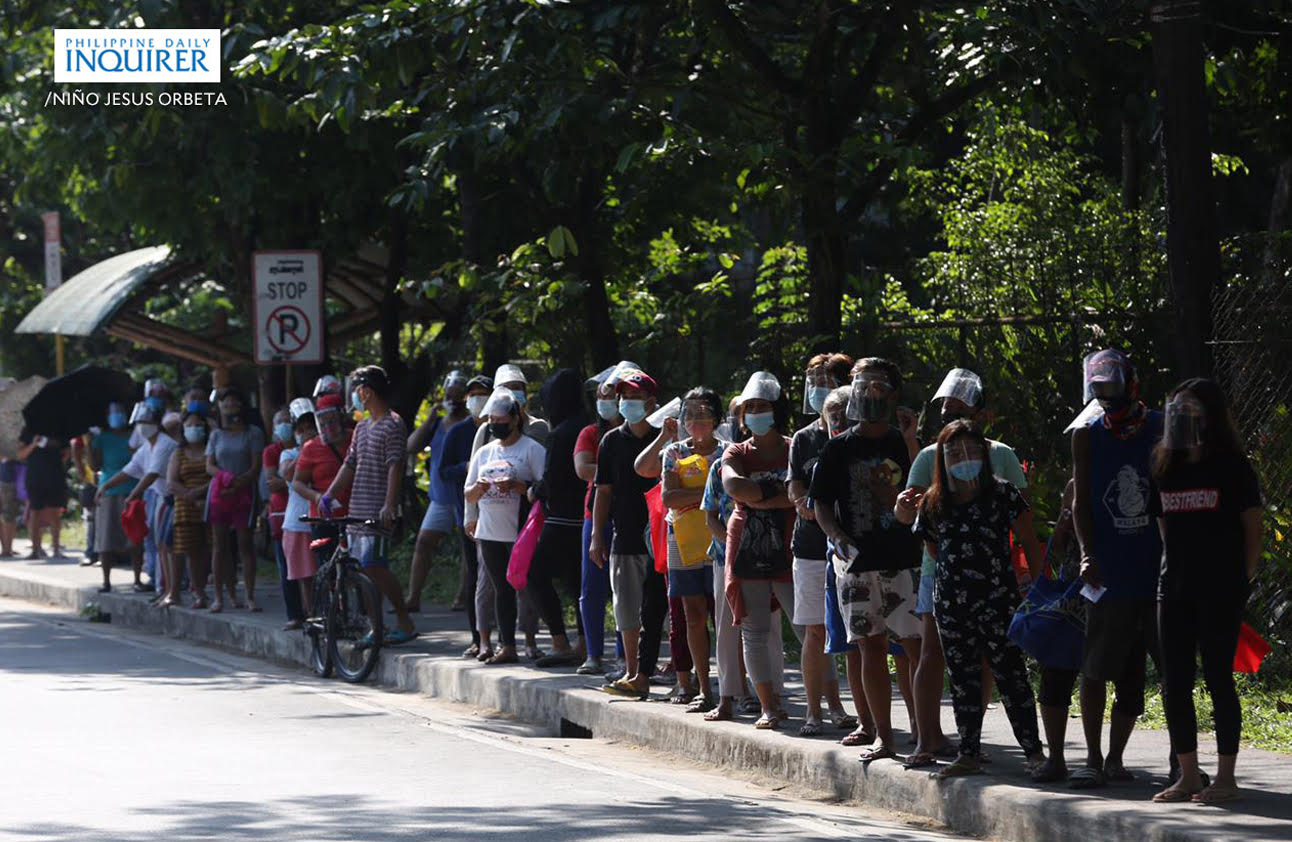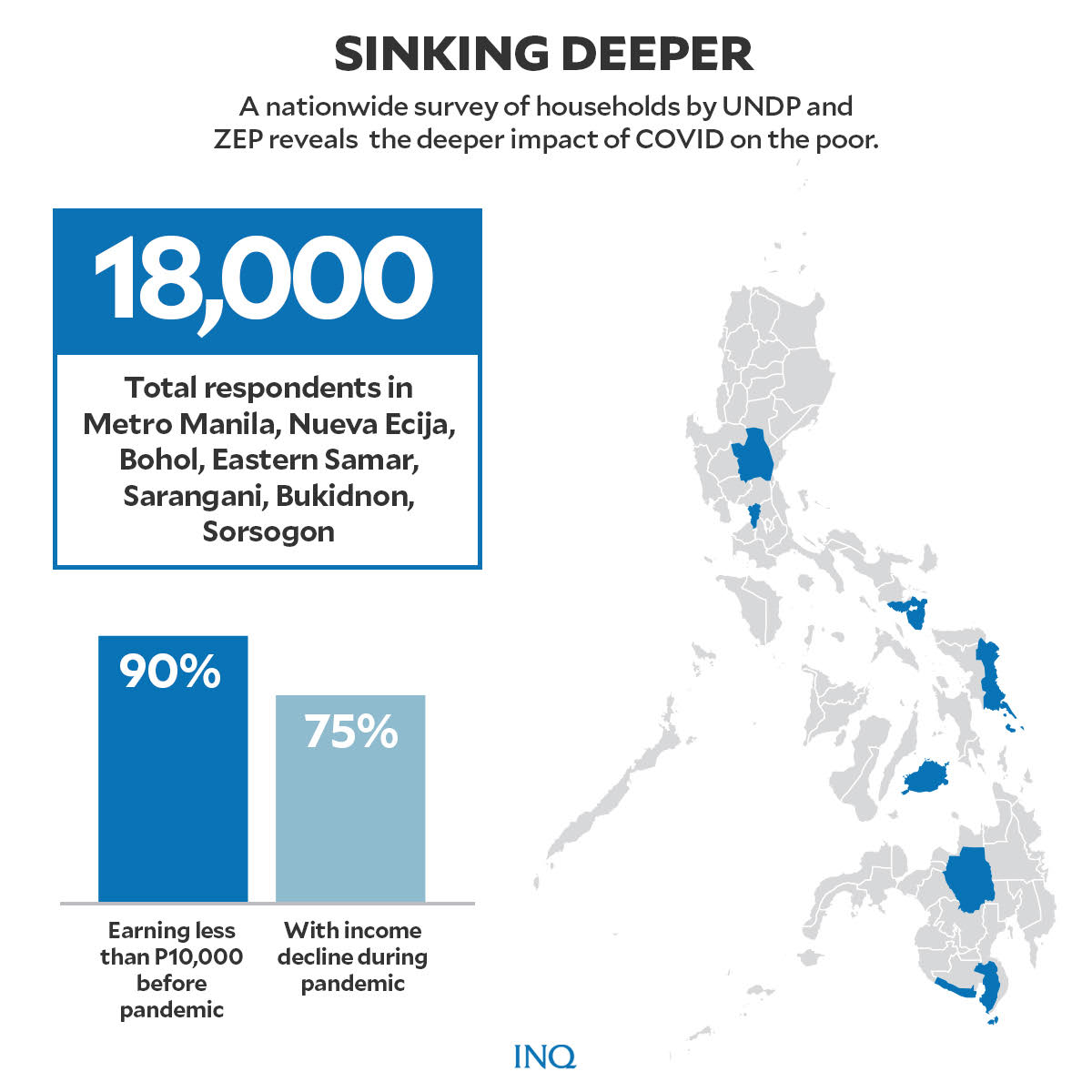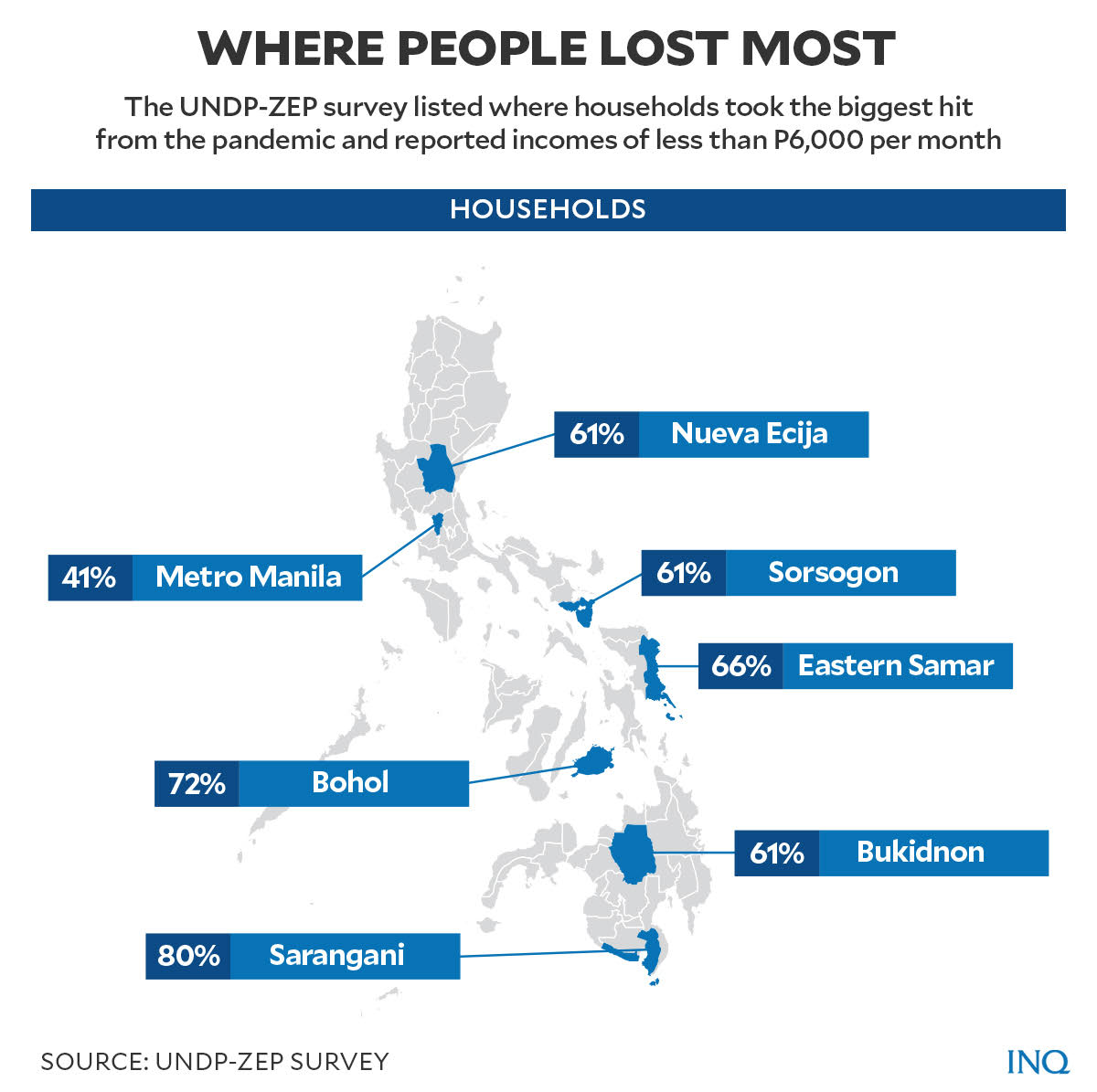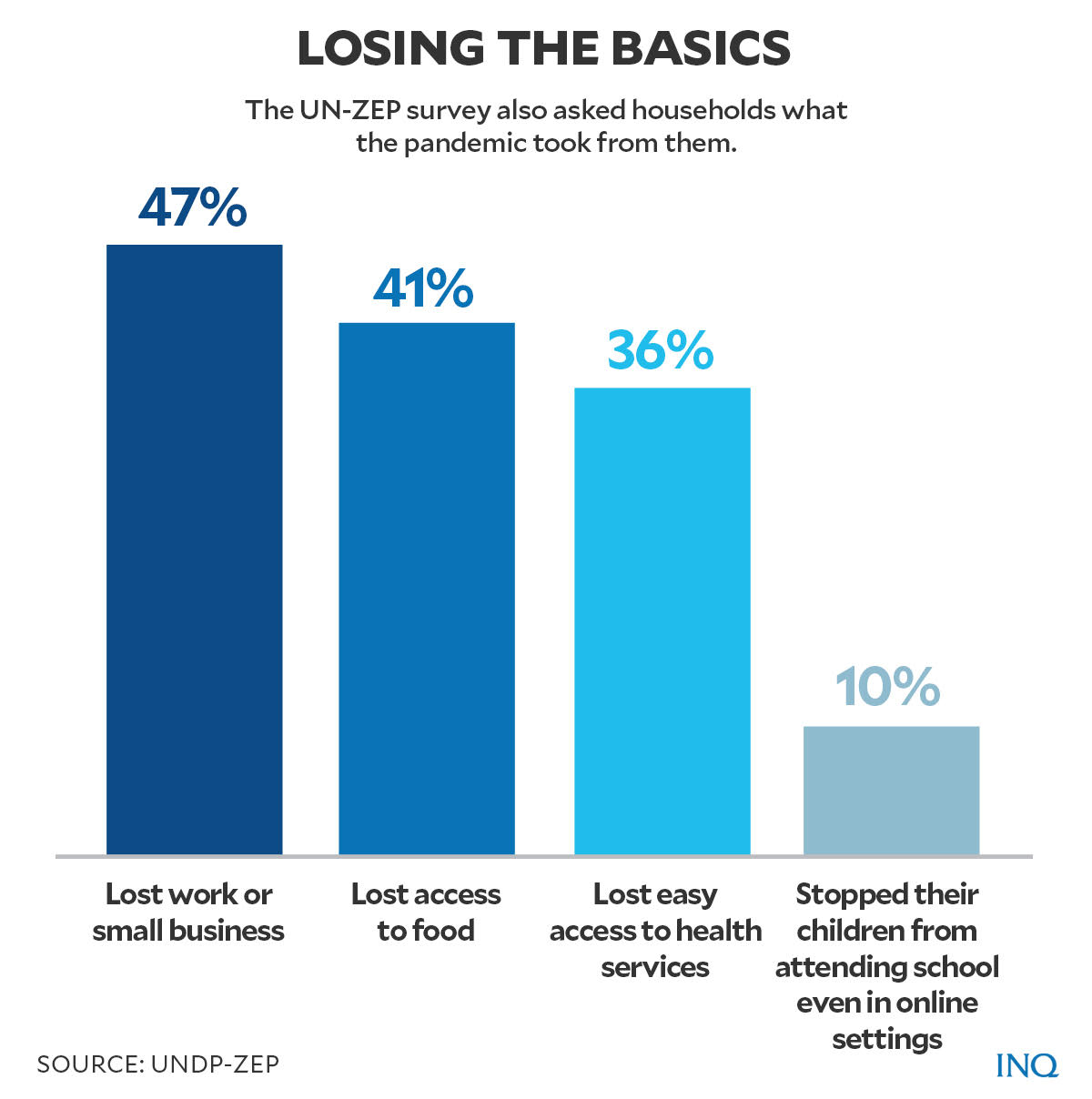From P10,000 to P6,000 a month: How PH poor are sinking deeper

FILE PHOTO: Residents queue for free food at a community pantry in Quezon City on April 21, 2021. NIÑO JESUS ORBETA/PHILIPPINE DAILY INQUIRER
MANILA, Philippines—The numbers that emerged in a survey on poverty during the pandemic by a United Nations agency and a Philippine non-government organization are showing what people on the ground may already know—people are sinking deeper in poverty.
READ: Pandemic sinks PH poor even deeper
Francis Capistrano, the United Nations Development Program (UNDP) Philippines’ head of experimentation, said that the poor “continue to struggle from the disproportionate impacts” of the COVID-19 crisis.
Last Tuesday (Aug. 31) Capistrano presented the findings of the third phase of the survey COVID-19 Pulse PH that was initiated by the UNDP and Zero Extreme Poverty (ZEP) 2030, a local NGO, that offer a glimpse of how the Filipino poor is living through the pandemic.

Graphic by Ed Lustan
READ: World Bank: Pandemic to sink 2.7M more Filipinos in poverty
COVID-19 Pulse PH asked more than 18,000 low-income households in Metro Manila, Nueva Ecija, Bohol, Eastern Samar, Sarangani, Bukidnon and Sorsogon about their economic conditions during and shortly before the pandemic.
Results showed that before the COVID-19 crisis in the Philippines, the poor were already suffering from lack of income. It said that 90 percent of respondents were earning less than P10,000 per month. Of these, at least 63 percent said they were earning less than P6,000 monthly.
READ: As poverty worsens, Duterte admin parades increments of good news
The report said that Sarangani province registered the highest rate of households earning less than P6,000 monthly. It was followed by Bohol (72 percent), Eastern Samar (66 percent), Sorsogon (61 percent), Bukidnon (61 percent), Nueva Ecija (61 percent), and Metro Manila (41 percent).

Graphic by Ed Lustan
However, with restrictions and hard lockdowns imposed by the government since 2020, 75 percent experienced a decrease in their already insufficient income.
In Sarangani, 80 percent had a decrease in income. It was followed by Bohol (78 percent), Sorsogon (77 percent), Eastern Samar (76 percent), Bukidnon (73 percent), Nueva Ecija (72 percent), and Metro Manila (69 percent).
Dianne Galarosa, a flower vendor, told INQUIRER.net that, like those asked by the UNDP and ZEP, her income decreased since 2020.
“In 2019, I could sell a lot so I had a higher income to finance my needs and my household but because of COVID-19 restrictions, my sales weakened,” she said.
READ: Only 17% of Pinoy families feel they’re not poor, 49% say they are — SWS
The UNDP report said that while the impact of the crisis has been concentrated in densely populated metropolitan areas, “its effects on incomes and livelihoods were felt nationwide.”
Galarosa said she’s doing everything to make a living in the midst of the pandemic but “it’s really hard now.”
READ: Poor fend for themselves amid gaps in gov’t pandemic response
She said that before the start of the COVID-19 crisis, she had been earning P10,000 a month. Now, the highest she can earn from her sales is P6,000 per month.
The 18,000 poor households asked by the UNDP and ZEP consisted of 56 percent from the informal sector—seasonal or casual workers, ambulant vendors or those with unregistered business, dependents, and those receiving pension.
The remaining 44 percent was from the formal sector—contractual workers, permanent or regular workers, and those with registered small business.
Intense impact
The UNDP and ZEP report said that 58.2 percent of the surveyed households said that their income “worsened” in March 2021 compared to last year, 29.6 percent said that it was still the same, while 12.1 percent said it improved.
READ: Pandemic in PH: Misery beyond numbers
Marites Busto, a lugaw (porridge) vendor, said that over a year since the start of the COVID-19 crisis, her situation has not improved but even worsened.
“It remains hard for us to cope, especially because we don’t have a choice when we are being told to temporarily stop when restrictions and hard lockdowns are imposed,” she told INQUIRER.net.
READ: PH economy sinks deeper into recession
The 58.2 percent of respondents said the following were the reasons for their loss of income in 2021:

Graphic by Ed Lustan
- Restrictions in movement
- Lower revenues despite maintaining a source of income
- Inability to find regular work or livelihood
In the provinces, Sarangani reported the highest rate of families whose incomes worsened (74 percent) followed by Nueva Ecija (69 percent) and Bohol (65 percent).
READ: Pandemic dug deeper pit for PH poor—study
The report said that 47 percent lost work or business, 41 percent experienced hunger, 36 percent had difficulty in accessing health services and 10 percent had to make their children stop schooling even online.

Graphic by Ed Lustan
READ: SWS survey: PH hunger rate climbs in new all-time high amid pandemic
The few 12.1 percent, who were able to improve their income this year, said that it was because of government support, sideline work or business, return to previous work, support from family and friends, new work, online work or business, and support from non-governmental organizations.
READ: Economic suffering stays intense
‘Better normal’
The UNDP and ZEP said that the third phase of the COVID-19 Pulse PH likewise wants to check on the Filipino poor’s “outlook for the future.”
Based on the report, when asked to name three assets and capabilities that could help them thrive in the new normal, the households said the following:
- Basic business skills
- Membership in community organization
- Technical-vocational training
- Ownership of livestock
- Support from family and friends
With the impact of the COVID-19 crisis, the respondents said that it is also important to have savings for emergencies or capital for business, support from family and friends, and access to government assistance.
As they hope for a “better normal,” the respondents said their dreams were about steady livelihood (76 percent), enough food and basic needs (69 percent), and quality education for their children (41 percent).
TSB
For more news about the novel coronavirus click here.
What you need to know about Coronavirus.
For more information on COVID-19, call the DOH Hotline: (02) 86517800 local 1149/1150.
The Inquirer Foundation supports our healthcare frontliners and is still accepting cash donations to be deposited at Banco de Oro (BDO) current account #007960018860 or donate through PayMaya using this link.